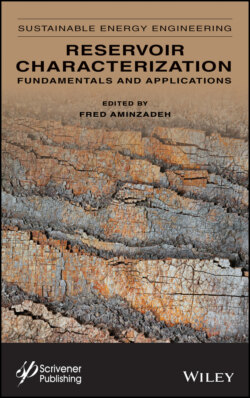Читать книгу Reservoir Characterization - Группа авторов - Страница 57
4.3 Results and Discussions
ОглавлениеAll 6 source rocks investigated are organically very rich (Table 4.1), showing TOC content in the 3.35% to 11.31% range. Results of Rock-Eval pyrolysis, such as hydrogen index (HI) and Tmax values indicates that all carbonaceous source rocks analyzed are highly enriched in sapropelic (Type II) kerogen (Figure 4.1) which based on Tmax-values appear to be thermally within the oil window (Figure 4.2). The pyrolysis results also indicate that the kerogen present in these source rocks show relatively high pyrolysis S2-peak values ranging from 7.74 to 15.13 mg HC/g rock, indicating that the kerogen present has a large remaining potential capable to generate hydrocarbons at higher maturity stages [5, 6].
The LC-results presented in Figure 4.3 indicate that the majority of the oils investigated are rich in aromatic hydrocarbons, with their polar compounds (resins and asphaltenes) present in relatively high proportions, characteristic of the aromatic-intermediate class. This class of oils includes most crude oils from Jurassic and Cretaceous sources of the Middle East [1].
Typical gas chromatograms (GC-fingerprints) of carbonate and shale-derived oils are presented in Figures 4.4 and 4.5, respectively. Carbonate-derived oil shows a pristane/phytane ratio below (i.e. a predominance of phytane over pristane), indicative of a reducing environment, while that of oil from shale facies shows a pristane/phytane above 1 [7–9].
As mentioned above almost all Tertiary oils studied (Figure 4.6 as an example) are relatively heavy and severely biodegraded. This can be seen from the absence of all normal alkanes, while Cretaceous oils analyzed are relatively light and non-biodegraded (Figure 4.7 as an example), with all normal and branced (iso-) alkanes being present.
Saturated and aromatic fractions of the oils and source rock bitumens were further analyzed by GC-MS to investigate their aliphatic (saturated) and aromatic biomarkers. Table 4.2 shows biomarker parameters of carbonate facies oils compared to those of shale-derived hydrocarbons.
Table 4.1 Results of TOC and Rock-Evaol Pyrolysis for the rock samples analyzed.
| Well name | Depth (ft) | % TOC⋆ | RE-SI⋆ | RE-S2⋆ | RE-S3⋆ | Tmax⋆ | HI⋆ | OI⋆ | SI/TOC⋆100 | PI |
|---|---|---|---|---|---|---|---|---|---|---|
| Well A | 14144 | 11.31 | 3.76 | 15.13 | 1.09 | 454 | 134 | 10 | 33 | 0.20 |
| Well A | 14171 | 9.34 | 3.44 | 9.98 | 1.43 | 451 | 107 | 15 | 37 | 0.26 |
| Well A | 14193 | 6.25 | 2.92 | 7.9 | 1.37 | 454 | 126 | 22 | 47 | 0.27 |
| WellB | 13709 | 3.35 | 9.19 | 3.57 | 1.00 | 448 | 107 | 30 | 274 | 0.72 |
| WellB | 13718 | 9.82 | 15.67 | 12.9 | 1.00 | 454 | 131 | 10 | 160 | 0.55 |
| WellB | 13726 | 5.88 | 5.11 | 7.74 | 0.64 | 455 | 132 | 11 | 87 | 0.40 |
⋆TOC = Total organic Carbon (wt%); SI = mg HCs/g rock; S2 = mg HCs/g rock; S3 = C02/g rockmg; Tmax = deg C; HI = Hydrogen index (mg HCs/g TOC); OI = oxygen index (mg/C02/g TOC).
Figure 4.1 Type of Kerogen present in source rocks.
The following are the significant observations that could be obtained from Table 4.2 and GC-MS biomarker results:
Carbonate oils show Pristane/phytane ratios below one, whereas pristane/phytane ratios of shale facies oils are around or above one.
Carbonate oils are more enriched in αβ-hopanes than steranes, showing lower steranes/αβ-hopanes ratios, whereas in shale-derived oils steranes are more abundant than hopanes, showing high steranes/αβ- hopanes ratios [2].
Figure 4.2 It shows kerogen conversion and maturity (Tmax).
Figure 4.3 Bulk compositions of oils and bitumen studied.
Figure 4.4 GC-Fingerprint of a carbonate-derived oil.
Figure 4.5 GC-Fingerprint of a shale facies derived oil.
Figure 4.6 GC- Fingerprint of Tertiary Oil No. 3 which is severely biodegraded.
Figure 4.7 GC- Fingerprint of Cretaceous Oil No. 3 which is not biodegraded.
Table 4.2 Typical biomarker characteristics of shale and carbonate-derived hydrocarbons.
| Biomarker parameter | Shales | Carbonates |
|---|---|---|
| Pristane/Phytane | Often ≥ 1 | Often ≤ 1 |
| Steranes/αβ-hopanes | High | Low |
| Diasteranes/steranes | High | Low |
| C24 tetracyclic/C26 tricyclic terpanes | Low-medium | Medium-high |
| C29/C30 hopanes | Often low | Can be high (>1) |
| C35 Homophone Index | Often low | Often high (>0.1) |
| Hexacyclic hopanes & benzohopanes | Low | High |
| Dibenezothiophene/phenanthrene | Low (<3) | High (>1; Often >3) |
| αββ steranes | Low-medium | Medium-high |
Carbonate-derived oils (Figure 4.8) often display a predominance of C29-hopane (norhopane) over C30-hopane (hopane), with C29/C30 hopane ratios above one.
In contrast, shale-derived oils show triterpene patterns (Figure 4.9 as an example) in which C29-hopane is predominant over C30-hopane, with a C29/C30 hopane ratio being low (mostly below one).
The Dibenzothiophene/Phananthrene ratio [10] is relatively high (mostly above 1) in carbonate oils (Figure 4.10), while those in shale-derived oils are low (mostly below 1).
Figure 4.8 Triterpane fingerprints of carbonate-derived oil.
Figure 4.9 Triterpane fingerprint of shale-derived oil.
Figure 4.10 Cross plot of dibenzothiophene/phenanthrene versus pristane/phaytane.
